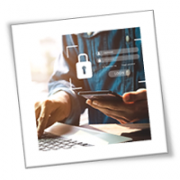We use passwords for just about everything. Most of us have to enter a password to get into our computers and then enter other passwords to access our e-mail, social media profiles, databases, and other accounts. Even our cell phones and tablets can and should be password protected. In fact, if you aren’t securing all of your devices and accounts with passwords, you should definitely start. It could help prevent your business and personal information from becoming compromised.
Why Passwords?
We use passwords to ensure that those who don’t have access to our accounts, can’t get access. Most of our devices hold large amounts of personal information. Think about the potential harm someone could do if they gained access to your personal cell phone. They would immediately be able to see all of your contacts, pictures, and applications. They might even be able to log in to your e-mail, where they could obtain your banking information. If this type of access falls into the wrong hands, it could be detrimental to your life. Passwords offer the first line of defense to prevent others from obtaining sensitive information.
This becomes even more important if you own a business. Each of your employees should be utilizing strong passwords to access company information. If your business is not using passwords – or is using simple passwords – you could be opening yourself up to hackers and cybercriminals. If a cybercriminal gains access to your company’s private information through a weak password, they will gain access to customer information which could damage your reputation and open you up to lawsuits. That being said, everyone within your business needs to utilize complex and unique passwords.
Making A Strong Password
Not all passwords are created equal. When it comes to making a strong password, you must think about it. If you use a password that you can’t remember, then it’s essentially useless. And if you use a password that’s too easy to remember, your password probably won’t be strong enough to keep cybercriminals out. Your password should be long, have a mix of lowercase and uppercase letters, utilize numbers and special characters, have no ties to personal information, and should not be a word from the dictionary.
In the grand scheme of things, it’s not enough to just create complex passwords. They also need to be unique. In addition to this, you should use a different password for each and every one of your accounts to help maximize their effectiveness. Think about it this way: Let’s say you use the same password across your business e-mail accounts, social media accounts, and bank accounts. If someone decrypts the password for your Facebook page, they now have the password for more valuable accounts. If you can’t tell that your social media account was compromised, the cybercriminal could try to use that same password to gain access to more important accounts. It’s a dangerous game that can be avoided by using unique and complex passwords for every account you use.
Remembering All Of These Passwords
You may be worried about remembering all of your passwords if you have to create a unique one for each of your accounts. Your first thought may be to write them down, but that might not be the most secure option. If someone gets their hands on your little black book of passwords, they’ll immediately gain access to all of your accounts with a handy directory showing them exactly where to go. Instead, you should utilize a password manager to help keep track of all of this sensitive information.
With a password manager, you only have to worry about remembering the master password for your password manager. All of your other passwords will be securely hidden. Password managers also give you the option to create random passwords for your accounts to bolster their security. That way you can have the most complex password possible without worrying about forgetting it. Additionally, password managers can also help you remember the answers to security questions and more so that you never get accidentally locked out of one of your accounts. They’re easy to use, convenient and secure.
Passwords are an important part of your cyber security plan. Make sure you and your employees are using complex and unique passwords. It can also help to implement some training so your employees understand the importance of secure passwords. When used correctly, passwords will help deter any would-be cybercriminals from accessing your sensitive information.
Are you interested in learning more about cybersecurity? Call us today and discover how our wide array of tech services can safeguard your business.
If you are looking for an expert to help you find the best solutions for your business talk to GCInfotech about a free technology assessment
Published with consideration from TechAdvisory.org SOURCE






